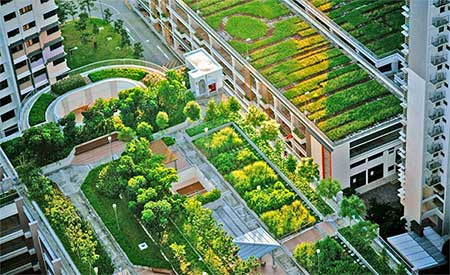We depend on pollinators more than most people realize. Bees, butterflies, and other pollinators play a huge role in keeping our food system and ecosystems alive.
But in cities, they’re running out of places to live and feed.
The good news? Our rooftops can help fix that.

We don’t need a giant space or a green thumb. Just a little effort and the right plants can turn our rooftops into buzzing, fluttering pollinator havens.
Let’s walk through simple steps to make it happen.
Why Rooftop Pollinator Gardens Matter
Pollinator populations keep dropping year after year. We lose their natural homes to new construction, pesticides harm them, and climate change shifts their food sources.
Urban rooftops offer us a solution we haven’t fully used yet. These spaces can provide food and shelter for bees, butterflies, and other pollinators right where they need it most.
Think about it – rooftop give us benefits beyond helping pollinators:
- They manage stormwater runoff
- They insulate buildings and save energy
- They make our cities more beautiful
We create win-win situations when we design rooftop gardens for both people and wildlife.
Planning Your Rooftop Pollinator Garden
Before we start planting, we need to know what we’re working with.
Here’s how to plan smart:
Check your roof:
- Can it hold extra weight?
- Is it super windy up there?
- How much sunlight does it get?
- Are there building codes or permits to follow?
If you are unsure about anything, look for a contractors in your area to give you a hand.
Design the space:
We can mix people space and pollinator space:
- Add a small seating area with a path
- Place planting beds around the edges
- Keep certain zones quiet just for wildlife
This way, we enjoy the garden too, without disturbing the bees and butterflies.
Choosing the Right Plants
Native plants work best for local pollinators. They’ve evolved together over thousands of years. Native species also handle local weather better than exotic plants.
We need flowers blooming from spring through fall. Plan for overlapping bloom times so pollinators always find food.
Choose plants with different flower shapes and sizes:
| Flower Type | Good For | Examples |
| Flat, open flowers | Butterflies | Black-eyed Susan, Coneflower |
| Tubular flowers | Hummingbirds, long-tongued bees | Bee Balm, Cardinal Flower |
| Clustered small flowers | Small bees, beneficial wasps | Yarrow, Wild Bergamot |
Pick drought-tolerant and wind-resistant species. Rooftops create tough growing conditions with hot sun and drying winds.
Planting and Layout Tips
The way we plant matters just as much as what we plant.
Try these tips:
- Group flowers in clusters: This makes it easier for pollinators to find them.
- Add some height: Use trellises or tall grasses for shelter and variety.
- Mix deep and shallow beds: This creates different growing spaces for different plants.
- Add a water spot: A shallow dish with pebbles lets pollinators drink safely.
Keep it simple. Keep it welcoming.
Maintenance and Eco-Friendly Practices
We must avoid pesticides and herbicides. These chemicals kill the pollinators we’re trying to help and harm beneficial insects that control pest problems naturally.
Organic mulch and compost improve soil health and help soil hold moisture, which is especially important on hot, windy rooftops.
Leave plant stems and debris over winter. Many native bee species nest in hollow stems, and some beneficial insects overwinter in plant material.
Watch your plants and pollinators throughout the growing season. Take notes about which plants attract the most visitors. Replace plants that struggle or don’t attract pollinators.
Overcoming Rooftop Challenges
Rooftop gardens are rewarding but come with a few unique hurdles.
Here’s how we can handle them without too much stress:
Wind
Rooftops are often windier than ground-level gardens. Strong gusts can damage plants or dry out the soil quickly.
- Use short, sturdy plants like sedum, lavender, or ornamental grasses that can handle the wind.
- Install windbreaks such as trellises, screens, or strategically placed planters to reduce wind exposure.
- Anchor containers securely or group them together to prevent tipping or sliding in strong winds.
Soil Weight
Weight is one of the most important things to consider. Roofs can only hold so much before they become unsafe.
- Use lightweight soil blends made with compost, coconut coir, and perlite to reduce pressure on the structure.
- Choose lightweight containers such as fabric grow bags or plastic pots over heavy ceramic or stone.
- Don’t overload the roof—consult a structural engineer or building manager before adding anything heavy.
Watering
Consistent watering is crucial on rooftops, especially those exposed to more sun and wind, as it dries things out faster.
- Set up a hose connection on the rooftop or near the access point to avoid hauling buckets.
- Install a basic drip irrigation system or soaker hoses to make watering the rooftop garden easier and more efficient.
- Use mulch or water-retaining soil additives to help hold moisture in and reduce how often we need to water.
Small steps go a long way to keep our rooftop garden thriving.
Wrapping Up
We can turn unused rooftop space into a valuable pollinator habitat. The steps are straightforward: check structural limits, choose native plants, create clusters of flowers, and avoid harmful chemicals.
Every rooftop garden helps. We don’t need huge spaces to make a difference. Even small containers with the right plants can feed hungry pollinators.
Start planning your rooftop pollinator garden today. Bees, butterflies, and our urban ecosystems need our help.
Together, we can sustainably create a network of pollinator-friendly rooftops that support wildlife and make our cities more livable for everyone.




